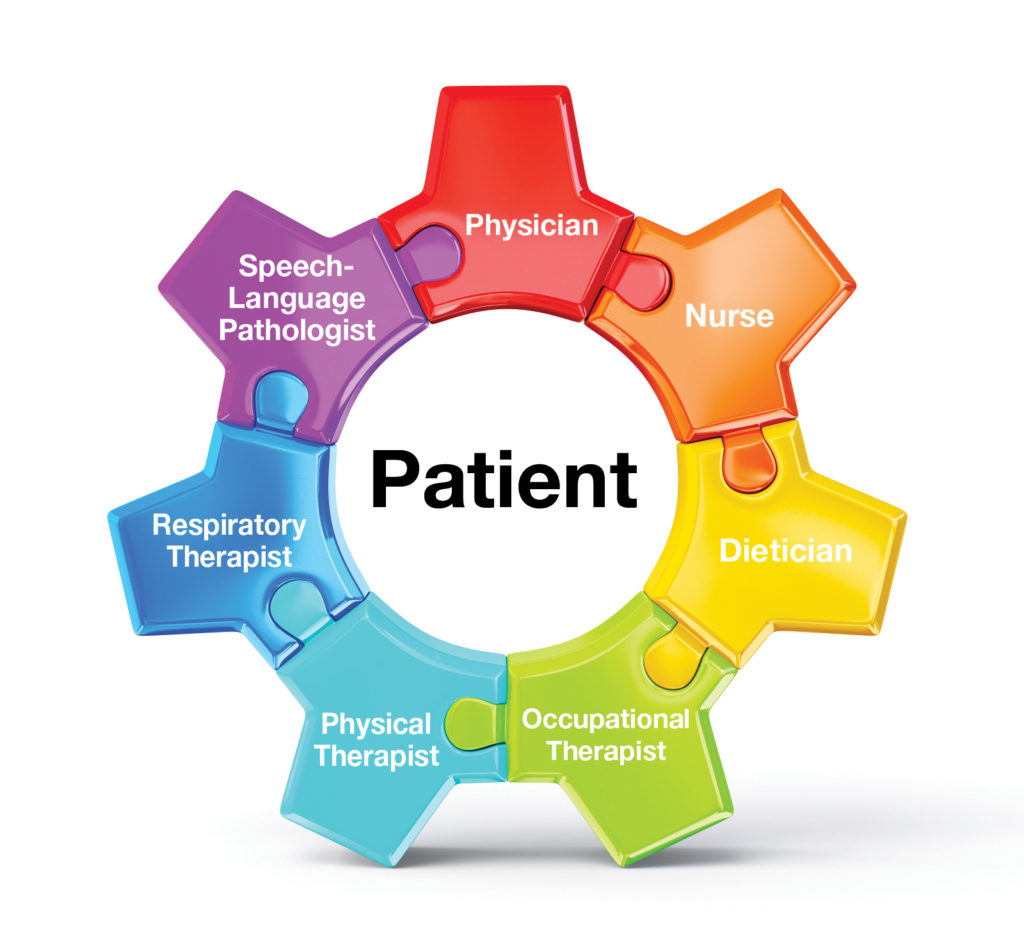This content is sponsored by Passy-Muir
What is a trach team?
A tracheostomy team (“trach team”) is a dedicated multidisciplinary group of medical professionals who specialize in tracheostomy practice. Trach teams are institution specific and there is not a “typical” model. However, most trach teams have common goals such as:
- Standardizing tracheostomy practice
- Providing safe and high-quality tracheostomy care
- Establishing an optimal means of communication for all patients with tracheostomy tubes
- Delivering on-going education and support to patients, caregivers, and staff regarding tracheostomy management
- Delivering cost effective care to patients with tracheostomy
- Avoiding poor outcomes and adverse events related to tracheostomy
- Improving the quality of life for patients with tracheostomy
Who needs a trach team?
Any pediatric or adult healthcare facility that performs tracheotomies or cares for patients who have tracheostomy tubes can benefit from a tracheostomy team.
Why do we need trach teams?
Numerous inconsistencies have been reported regarding tracheostomy tube management such as sizing of the tube, initial tracheostomy tube change, management of cuffs, decannulation protocols, timing of communication and swallowing evaluations, emergency procedures, care and cleaning, and patient and family education (deMestral et al. 2011; Mitchell et al. 2013; Norwood et al. 2004). St. Clair (2005) reported that that inconsistencies in tracheostomy management represent a patient safety threat in the form of nosocomial infections, prolonged hospitalizations, airway complications, and death.
The lack of standardized care and the associated complications have led several institutions to develop multidisciplinary tracheostomy teams. Many of these institutions have reported improved patient outcomes following implementation of a trach team. Santos et al. (2018) found numerous improvements in post-tracheostomy care and patient outcomes with use of a dedicated tracheostomy team. The authors reported decreased ICU length of stay and total hospital length of stay, expedited weaning from the ventilator, earlier use of Passy-Muir Valves, earlier decannulation, fewer tracheotomy-related complications, and earlier oral diet initiation. Sindi et al. (2016) studied the impact of a specialized multidisciplinary tracheostomy team on tracheostomy care and reported a significant reduction in tracheostomy complications and faster decannulation time after implementation of a trach team. Mussa et al. (2021) completed a systematic review to facilitate the development of recommendations relevant to the care of adult patients with tracheostomy in the acute care setting. This review led to the development of the AARC Clinical Practice Guideline: Management of Adult Patients with Tracheostomy in the Acute Care Setting. The authors reported that evidence supports the use of a multidisciplinary tracheostomy team to improve decannulation time, length of stay, tracheostomy-related adverse events, and increase speaking valve use. Thus, one of the recommendations was to utilize a dedicated multidisciplinary tracheostomy team to manage patients with tracheostomies.
Multidisciplinary teams have also been studied in the pediatric population. Chorney et al. (2021) reported increased referrals to the speech-language pathologist, decreased length of stay, and cost savings after establishing a pediatric multidisciplinary tracheostomy team. McKeon et al. (2019) found that by implementing a pediatric trach team, patients experienced a significant reduction in tracheostomy-related adverse events. The authors suggest that “a multidisciplinary tracheostomy team may be a powerful tool for enhancing patient safety and quality improvement” (McKeon et al. 2019).

How do we start a trach team?
This next section provides potential suggestions to develop and implement a tracheostomy team; however, the specific steps taken to create a trach team vary facility to facility.
- Review external resources. The following links provide a wealth of information regarding tracheostomy management, the role of the SLP as part of the tracheostomy team, the importance of communication including details about use of the Passy-Muir Valve with and without mechanical ventilation, sample tracheostomy documentation, supportive research, and the role and benefits of tracheostomy teams:
- Global Tracheostomy Collaborative
- Tracheostomy Review and Management Service (TRAMS)
- UK National Tracheostomy Safety Project
- Passy-Muir, Inc.
- Review internal resources and documents.
- Policies and procedures
- Tracheostomy order sets
- Patient and family education
- Decannulation pathways
- Collect data to establish the need for a trach team.
- Conduct staff, patient, and family surveys
- Gather information on current tracheostomy practices
- Type of tracheotomies performed
- Number of tracheostomies performed
- Number of patients with tracheostomies
- Adverse events
- Length of stay
- Cost
- Gather the team.
- Find healthcare providers who are knowledgeable about tracheostomy practice and have a mutual desire to standardize care and improve patient outcomes
- Potential team members include:
- Physician
- Respiratory therapist
- Nurse
- Nurse practitioner
- Occupational therapist
- Physical therapist
- Registered dietician
- Case Manager
- Speech-language pathologist (SLP)
- An integral member of the tracheostomy team.
- The role of the SLP includes:
- Collaborating on types and sizes of tracheostomy tubes needed to facilitate improved communication and swallowing.
- Providing communication intervention including early use of the Passy-Muir Valve.
- Several studies reported earlier use of PMVs once a tracheostomy team was implemented (Cameron et al. 2009; Santos et al. 2018; Speed and Harding, 2013). Early use of the PMV allows patients to communicate verbally, improves quality of life and cough function, and reduces tracheal secretions (Speed & Harding, 2013).
- Early speaking valve use has also been studied in the pediatric population. Kam et al. (2022) reported that use of a multidisciplinary protocol for speaking valve use in a pediatric hospital resulted in significant decrease in time from tracheostomy to the first speaking valve trial.
- Providing dysphagia intervention.
- Rounding with the multidisciplinary team.
- Delivering patient, family, and staff education.
- McGrath and Wallace (2014) reported that the role of the SLP is key, “not only in assessing and managing swallowing and communication needs, but in contributing experience and expertise to all relevant tracheostomy-related decisions, as part of the MDT process” (McGrath & Wallace, 2014).
- Initial team meetings and decision making.
- Once the team members have been established, the team should schedule regular meetings to begin decision-making. Decisions should be based on team member expertise, internal and external evidence, consensus statements, and practice guidelines. Topics of discussion should include:
- Roles and responsibilities of each team member
- Tracheotomy procedure
- Tracheostomy sizing
- Timing of first tracheostomy change
- Tracheostomy care
- Tracheostomy order set
- Patient and family education
- Emergency procedures
- Cuff protocols
- Decannulation pathway
- Wound and stoma management
- Team rounds
- Once the team members have been established, the team should schedule regular meetings to begin decision-making. Decisions should be based on team member expertise, internal and external evidence, consensus statements, and practice guidelines. Topics of discussion should include:
- Garner support from administration.
- Gaining support from administration is an essential step in establishing a successful tracheostomy team. One important point to make with upper management is the potential for cost savings with implementation of a tracheostomy team. Many institutions have reported decreased length of stay and significant cost savings after establishing a trach team (Mirski et al. 2012, Cameron et al. 2009, deMestral et al. 2011).
What are the team tasks?
- Developing new documentation
- Policies and procedures
- Order sets (which should include orders to nursing, respiratory therapy, occupation and physical therapy, registered dietician, and speech-language pathology)
- Patient and family education
- Rounding checklists
- Emergency procedures
- Patient charting templates
- Performing the tracheotomy
- Managing the tracheostomy tube from insertion through decannulation
- Collecting data
- Delivering patient, family, and staff education
- Attending team rounds. Rounding tasks include:
- Tracheostomy management such as cleaning, changing the inner cannula, cuff management, changing the dressing and trach ties, changing the tracheostomy tube, and decannulation
- Checking status of ventilator weaning, vital signs, level of alertness, nutrition, cough, and secretion management
- Addressing communication
- Assessment and placement of the Passy-Muir Valve may occur during team rounds. Teamwork between RT and SLP is needed for patients with mechanical ventilation
- Documentation of team rounds and tasks
Summary:
Development and implementation of a tracheostomy team requires persistence, dedication, and time investment for all members of the team. Although this may seem like a formidable challenge, it is a worthwhile endeavor. Research has shown that use of a multidisciplinary tracheostomy team can significantly reduce adverse events, and can have a positive impact on ventilator weaning, communication, decannulation time, oral intake, length of stay, cost, and quality of life of the patient with a tracheostomy in both the adult and pediatric patient populations.
*This is a sponsored post from Passy-Muir.
References
Cameron, T., McKinstry, A., Burt, S., Howard, M., Bellomo, R., Brown, D., Ross, J., Sweeney, J., & O’Donoghue, F. (2009). Outcomes of patients with spinal cord injury before and after introduction of an interdisciplinary tracheostomy team. Critical Care and Resuscitation, 11(1), 14-19.
Chorney, S. R., Brown, A. F., Brooks, R. L., Bailey, C., Whitney, C., Sewell, A., & Johnson, R. F. (2021). Pediatric Tracheostomy Outcomes After Development of a Multidisciplinary Airway Team: A Quality Improvement Initiative. OTO Open, 5(3), 2473974X211045615. https://doi.org/10.1177/2473974X211045615
de Mestral, C., Iqbal, S., Fong, N., LeBlanc, J., Fata, P., Razek, T., & Khwaja, K. (2011). Impact of a specialized multidisciplinary tracheostomy team on tracheostomy care in critically ill patients. Canadian Journal of Surgery, 54(3),167-172. https://doi:10.1503/cjs.043209
Kam, K., Patzelt, R., & Soenen, R. (2022). Pediatric tracheostomy speaking valves: A multidisciplinary protocol leads to earlier initial trials. Journal of Child Health Care: For Professionals Working with Children in the Hospital and Community, 13674935211070416. Advance online publication. https://doi.org/10.1177/13674935211070416
McGrath, B. & Wallace, S. (2014). The UK national tracheostomy safety project and the role of the speech and language therapists. Current Opinion in Otolaryngology and Head and Neck Surgery, 22(3), 181-7. https://doi:10.1097/MOO.0000000000000046
McKeon, M., Kohn, J., Munhall, D., Wells, S., Blanchette, S., Santiago, R., Graham, R., Nuss, R., Rahbar, R., Volk, M., & Watters, K. (2019). Association of a Multidisciplinary Care Approach With the Quality of Care After Pediatric Tracheostomy. JAMA Otolaryngology– Head & Neck Surgery, 145(11), 1035–1042. https://doi.org/10.1001/jamaoto.2019.2500
Mirski, M. A., Pandian, V., Bhatti, N., Haut, E., Feller-Kopman, D., Morad, A., Haider, A., Schiavi, A., Efron, D., Ulatowski, J., Yarmus, L., Stevens, K. A., Miller, C. A., Papangelou, A., Vaswani, R., Kalmar, C., Gupta, S., Intihar, P., Mack, S., Rushing, A. P., … Roberts, V. J., Jr (2012). Safety, efficiency, and cost-effectiveness of a multidisciplinary percutaneous tracheostomy program. Critical Care Medicine, 40(6), 1827–1834. https://doi.org/10.1097/CCM.0b013e31824e16af
Mitchell, R., Parker, V., & Giles, M. (2012). An interprofessional team approach to tracheostomy care: A mixed-method investigation into the mechanisms explaining tracheostomy team effectiveness. International Journal of Nursing Studies, 50(4), 536-542. https://doi:10.1016/j.ijnurstu.2012.11.008
Mussa, C., Gomaa, D., Rowley, D., Schmidt, U., Ginier, E., & Strickland, S. (2021). AARC Clinical Practice Guideline: Management of Adult Patients with Tracheostomy in the Acute Care Setting. Respiratory Care, 66(1), 156-169. https://doi:10.4187/respcare.08206
Norwood, M., Spiers, P., Bailiss, J., & Sayers, R. (2004). Evaluation of the role of a specialist tracheostomy service. From critical care to outreach and beyond. Postgraduate Medical Journal, 80(946), 478-480. https://doi:10.1136/pgmj.2003.016956
St. Clair, J. (2005). A New Model of Tracheostomy Care: Closing the Research–Practice Gap. Advances in Patient Safety: From Research to Implementation (Volume 3: Implementation Issues). Agency for Healthcare Research and Quality (US); 2005 Feb. Retrieved from: https://www.ncbi.nlm.nih.gov/books/NBK20542/
Santos, A., Harper, D., Gandy, S., & Buchanan, B. (2018). The positive impact of multidisciplinary tracheostomy team in the care of post-tracheostomy patients. Critical Care Medicine, 46(1), 591-591.
Sindi, M. Sarwani, S., Sarwani, O. (2016) The Impact of Specialized Tracheostomy Care Team. Bahrain Medical Bulletin, 38(2), 94-96.
Speed, L., & Harding, K. E. (2013). Tracheostomy teams reduce total tracheostomy time and increase speaking valve use: A systematic review and meta-analysis. Journal of Critical Care, 28(2), 216.e1-10. https://doi:10.1016/j.jcrc.2012.05.005





